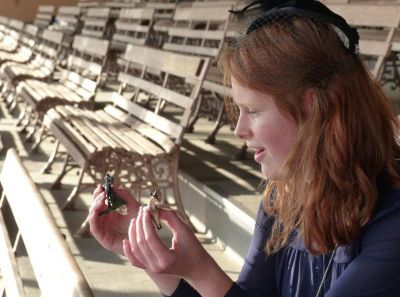Timon of Athens
The stories, characters, and themes put forth in the writings of William Shakespeare have endured long after the man’s death – and will surely continue to endure long after the death of anyone reading this – because they dramatize human frailties and human foibles that transcend the time in which his plays were first written and performed. On the other hand, Shakespeare’s language can prove daunting to modern audiences, so communication must be priority one for any company choosing to cast their lot with the Bard.
Timon of Athens is one of the least-known and least-performed works in the Shakespeare canon, and the very decision to tackle such a piece requires a level of courage and confidence that any critic must acknowledge. To combine a largely unfamiliar text with a non-traditional outdoor venue was a downright ambitious undertaking; unfortunately, this reviewer cannot profess to have been won over by the result. Though Symposium Productions have given us a generally well-spoken ensemble effort, the impact of this presentation feels compromised and its conception fundamentally flawed.
Described by director Mary Rose Angley as “a play about the buying and selling of friendship”, “exploring the effects of insecurity, desolation, and isolation”, Timon of Athens is enacted by a cast who appear more-than-adequate to the task of communicating these richly promising themes in dramatic terms. However, the decision to mount this production in The Grandstand of Victoria Park, rather than enhancing the experience, seems to have severely limited the creative team’s opportunity for generating a level of context necessary for appreciating this play.
 The possibilities available through the use of multimedia, a striking design concept, or even a complex lighting plot, are seemingly not able to be taken advantage of here, leaving the talented cast and the historical venue to shoulder the requirements that Timon of Athens carries with it – but for much of the play’s length, it’s simply not enough. Most of the performances manage to make an impact from scene to scene, but there is relatively little sense of the kind of cumulative drama that would make for a truly involving experience.
The possibilities available through the use of multimedia, a striking design concept, or even a complex lighting plot, are seemingly not able to be taken advantage of here, leaving the talented cast and the historical venue to shoulder the requirements that Timon of Athens carries with it – but for much of the play’s length, it’s simply not enough. Most of the performances manage to make an impact from scene to scene, but there is relatively little sense of the kind of cumulative drama that would make for a truly involving experience.
Billed as an ‘interactive’ presentation, the level of direct audience involvement consists of being served canapes by the cast prior to commencement, and of being required to relocate from our seats on a semi-regular basis in order to feel an actual sense of physical dimensions/distances between characters. While theoretically interesting tactics, neither really seemed to aid in the understanding of – or involvement with – this particular text. The task of finding one’s bearings in the world of Timon of Athens would be difficult enough under ordinary indoor theatrical circumstances; presenting it in this manner actually tends to make it more so.
 Relying on the audience to supply their own level of adequate personal insulation against whatever temperature an Adelaide spring evening may bring is also a risky enterprise, particularly when such close and careful concentration on the text is required. The decision to not directly match faces to names in the programme is a further error of judgement, a presumption that every viewer will find it equally easy to remember which character name belongs to which performer.
Relying on the audience to supply their own level of adequate personal insulation against whatever temperature an Adelaide spring evening may bring is also a risky enterprise, particularly when such close and careful concentration on the text is required. The decision to not directly match faces to names in the programme is a further error of judgement, a presumption that every viewer will find it equally easy to remember which character name belongs to which performer.
Despite the problems encountered by this reviewer with Timon of Athens, one still sincerely hopes in general to see more risk-taking in Adelaide theatre, but perhaps with a somewhat lesser degree of difficulty; a challenging play presented in a challenging venue is just one challenge too many.
Anthony Vawser
Subscribe to our E-Newsletter, buy our latest print edition or find a Performing Arts book at Book Nook.

